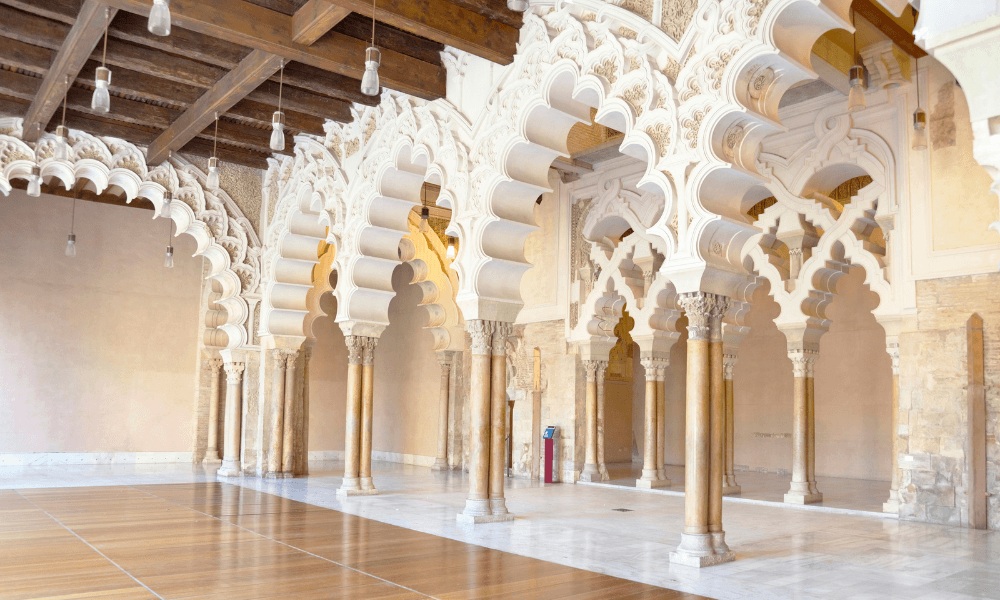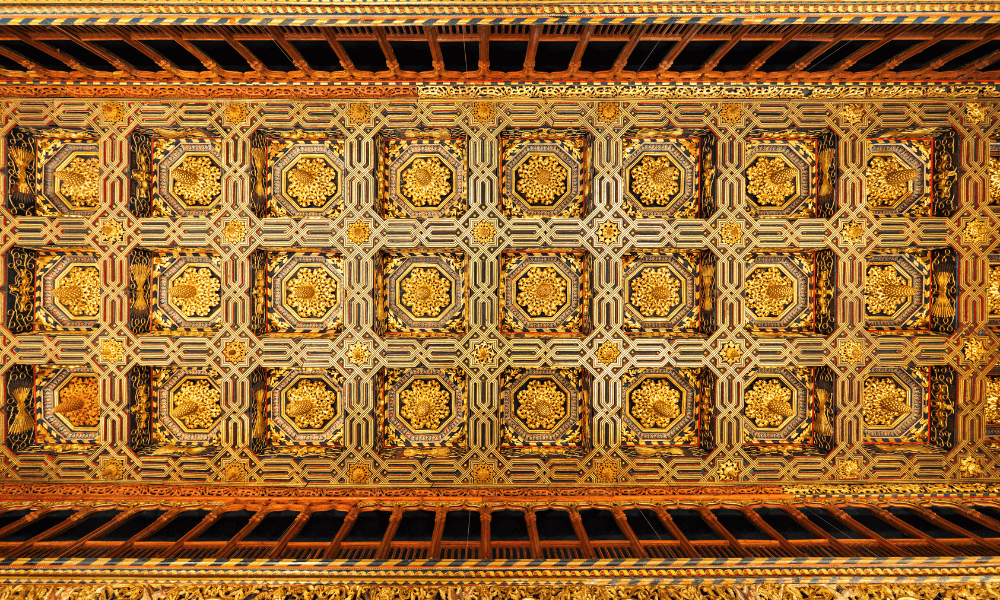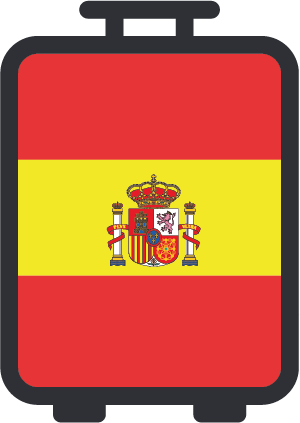
The Aljafería Palace is undoubtedly one of the main tourist attractions of Zaragoza, always appearing in the top rankings of websites and blogs on “what to do in Zaragoza“ and being considered one of the summits of Muslim art in our country, along with the Alhambra in Granada and the Mosque of Cordoba. In this article we are going to tell you 7 secrets to know before your visit to the Aljafería Palace, from its origins to the present, as well as how to get there and how to visit it. Welcome to the Muslim past of Zaragoza.
1. The origin of the Aljafería Palace
The Aljafería Palace in Zaragoza was built as a recreational residence and fortification for the Hudi kings in the 11th century, under the rule of King Al-Muqtadir. At that time, the present city of Zaragoza was called Saraqusta and was known as the “white city” because of the light color of its walls, being one of the Taifa kingdoms that at that time made up the peninsula (independent cities structured in the Iberian Peninsula after the dissolution of the Umayyad caliphate in the tenth century).
Its original name was Qasr al-Ja’fariyya, which means Palace of Joy, and clearly reflects the splendor reached by the Taifa kingdom of Saraqusta in the period of its maximum political and cultural apogee.
2. Residence of Christian kings…and of the Catholic Monarchs
After the reconquest of Zaragoza in 1118 by Alfonso I the Battler (whose monumental statue presides over the beautiful Parque Grande in Zaragoza), the Aljafería Palace passed into the hands of the Christian kings of Aragon and became one of the main centers for the diffusion of Aragonese Mudejar art. Important kings of the time lived here, such as Peter IV the Ceremonious, but undoubtedly the most illustrious figures of the nobility of those years who lived within the wide walls of the Aljafería Palace were the Catholic Monarchs, who undertook major reforms in the late fifteenth century, such as the construction of a palace on the north wing of the Islamic palace, in order to show the greatness of Ferdinand and Isabella, and to intimidate visitors with the wealth they showed. To access the Palace of the Catholic Monarchs, a grand staircase was built from the courtyard of Santa Isabel.
3. The Inquisition and arrival of Philip II
In the year 1485, the Palace of the Aljafería of Zaragoza became the seat of the Court of the Inquisition, with prisons included. A period of strong repression for the society of that time, which continued with the arrival of Philip II, who transformed it into barracks and ordered to make the appropriate reforms (carried out by the engineer Tiburcio Spanocchi), to adapt the palace-castle of the Aljafería to the new artillery weapons and a more elaborate defensive system with slope barriers and moats. As a final sign of repression, Philip II executed the Justice of Aragon Juan de Lanuza (a symbol of the freedoms of Aragon and whose statue presides over the central Plaza de Aragon), in 1591, in response to some revolts of the time and to prevent future social uprisings.
In later centuries, the palace continued to be modified with continuous reforms, suffering serious damage during the Sieges of Zaragoza and the War of Independence in the nineteenth century.

4. Spaces and halls of the Aljafería
Some of the main places to visit in the Aljafería Palace are:
– The walls, whose structure can be enjoyed splendidly both from near and far as there are no buildings near the palace.
– Courtyards such as San Martín or Santa Isabel.
– Torre del Trovador, one of the oldest structures of the palace that we will see more in detail.
– Salón Dorado or Salón del Trono, an essential place where the king of the Taifa received the authorities of other kingdoms to impress and intimidate them with its architectural wealth.
– Palace of the Catholic Monarchs, as we have previously seen.
5. The Aljafería and Giuseppe Verdi
The Aljafería Palace has a very close relationship with Giuseppe Verdi, one of the most important classical music composers of all times. The reason is the following: The oldest building in the entire palace is the so-called “Torre del Trovador”, which received this name because it was the narrative setting of the romantic drama by Antonio García called “The Troubadour”, and which was turned into an opera by the Italian Verdi in 1853 (“Il Trovatore”), thus granting worldwide fame to the work.
6. The Aljafería Palace nowadays
Currently, the Aljafería Palace in Zaragoza is the official seat of the Aragonese Parliament (the legislative body of the Community of Aragon), where plenary sessions and other political and social events of the Aragonese territory are held.
It is worth noting that in 2001 the palace was declared a World Heritage Site by UNESCO, as a key piece within the architecture and Mudejar art of Aragon.

7. Opening hours and prices to visit the Aljafería Palace
If you want to visit the Aljafería Palace, this is the relevant information you need to know (of course, we recommend you to check possible changes through the official website of the Aljafería and also to make the online reservation, which is essential to make the tour).
Opening hours: Monday to Sunday.
Hours from November to March: 10 am to 2 pm and 4 pm to 6:30 pm. Closed on Sunday afternoons. Guided tours: 10:30 am, 11:30 am, 12:30 pm, 4:30 pm and 5:30 pm.
Hours from April to October: 10:00 am to 2:00 pm and 4:30 pm to 8:00 pm. Guided tours: 10:30 am, 11:30 am, 12:30 pm, 4:30 pm, 5:30 pm and 6:30 pm.
Price: 5€ (ask for discounts). Free first Sunday of the month and first Monday of the month in the afternoon.
And… how to get to the Aljafería?
- The Aljafería Palace is located in Calle de los Diputados s/n, in the neighborhood of the Almozara and as we said before, it is easily spotted once you get to the surroundings. If you are in the historic center of the city and you want to leave your luggage in our luggage storage in Zaragoza downtown, the three best options available (according to your preferences and possibilities) from our local Megalockers in Manifestación street 24, are:
- Go walking. If you’ve already got rid of your luggage and have stored it for a few hours in our lockers in Zaragoza, walking is a great option. The journey takes about 20 minutes through the most central and historic area of the city.
- Go by bus. The best option is to go to Paseo Echegaray y Caballero (next to the Ebro River), to take bus number 36. You will easily locate your final stop when you see the Aljafería in front of you. In total, about 20-25 minutes.
- Take a taxi. If you prefer a faster and more comfortable option (although somewhat less economical), you can travel there by cab. You will get there in under 10 minutes (depending on traffic).
Visiting The Aljafería Palace is one of the best things to do in Zaragoza, so if you visit our city and want to go there, leave your luggage in our lockers and enjoy this impressive Muslim vestige of the capital of Aragon.




